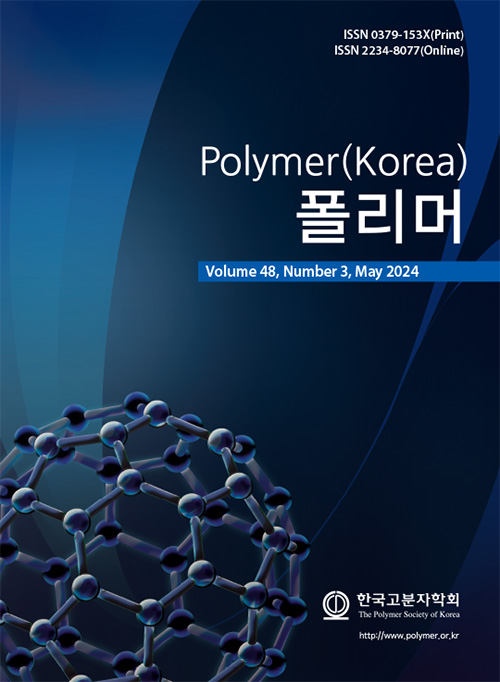- Antimicrobial Property of Polydimethylsiloxane Film Coated with Aminosilanes
Yeji Park, Sumin Jeong, Md Shahjahan Kabir Chowdury, SungBum Park*, and Yong-il Park†

School of Materials Science and Engineering, Kumoh National Institute of Technology, 61 Daehak-ro, Gumi, Gyeongbuk 39177, Korea
*Department of Automotive Materials and Components Engineering, Dongguk University WISE Campus, Gyeongju 38066, Korea- 아미노실란을코팅한폴리디메틸실록산필름의항균특성
국립금오공과대학교 신소재공학과, *동국대학교 WISE캠퍼스 자동차소재부품공학과
Reproduction, stored in a retrieval system, or transmitted in any form of any part of this publication is permitted only by written permission from the Polymer Society of Korea.
Due to the global pandemic of Covid-19, various studies are being conducted to overcome it. In the case of existing antibacterial plastics, a simple method of mixing various antibacterial agents into a polymer is used, but this has the disadvantage that the antibacterial activity gradually decreases as they are eluted from the polymer over time. To solve this problem, research is underway to chemically bond antibacterial functional groups to the polymer chains that make up the matrix. Antibacterial functional groups such as cations kill bacteria by disrupting or destroying the anionic cell membrane of bacteria, or causing metabolic disorders after diffusing into cells. In this work, we used a method to arrange an organic-inorganic complex aminosilane thin layer on the surface of polydimethylsiloxane (PDMS) film at a high concentration to maintain and maximize the antimicrobial activity. By bonding the hydrophilic alkoxy functional group to the substrate side, it is possible to orient the amine functional group toward the surface, thereby maximizing antibacterial properties. As a result, aminosilane hybrid coating layers showed excellent antibacterial activities and so we could solve the durability problem of the conventional antimicrobial plastics.
Covid-19의 전세계적 대유행에 따라 그 극복을 위한 다양한 연구가 진행되고 있다. 기존의 항균 플라스틱의 경우, 여러가지 항균제를 고분자에 혼합하는 단순한 방법을 사용하는데, 시간에 따라 고분자로부터 용출되어 항균력이 점차 감소하게 되는 단점이 있다. 이를 해결하는 방법으로 매트릭스를 이루는 고분자 사슬에 항균성 작용기를 화학 결합시키는 연구가 진행되고 있다. 양이온을 함유하는 항균성 작용기는 음이온성인 세균의 세포막을 교란 또는 파괴하거나, 세포 안으로 확산해 들어가 대사장애를 일으킴으로써 세균을 사멸시킨다. 본 연구에서는 항균성 작용기의 항균력의 지속과 이의 극대화를 위해 polydimethylsiloxane(PDMS) 필름 표면에 유-무기 복합성 아미노실란 박막을 고밀도로 배열시키는 방법을 사용하였다. 특히 친수성 알콕시 작용기가 기판측과 결합함으로써 아민 작용기가 표면 측으로 배향시키는 것이 가능하며, 이로써 항균성의 극대화가 가능하였다. 결과적으로, 아미노실란 하이브리드 코팅층이 우수한 항균력을 보였으며 이로써 기존 항균 플라스틱의 지속성 문제를 해결할 수 있게 되었다.
Keywords: biopolymers, coating materials, (3-aminopropyl)triethoxysilane, 3-aminopropyl(diethoxy)methylsilane, aminopropyldimethylethoxysilane, antimicrobial activity, polydimethylsiloxane.
- Polymer(Korea) 폴리머
- Frequency : Bimonthly(odd)
ISSN 0379-153X(Print)
ISSN 2234-8077(Online)
Abbr. Polym. Korea - 2023 Impact Factor : 0.4
- Indexed in SCIE
 This Article
This Article
-
2024; 48(3): 274-281
Published online May 25, 2024
- 10.7317/pk.2024.48.3.274
- Received on Nov 21, 2023
- Revised on Jan 8, 2024
- Accepted on Feb 20, 2024
 Correspondence to
Correspondence to
- Yong-il Park
-
School of Materials Science and Engineering, Kumoh National Institute of Technology, 61 Daehak-ro, Gumi, Gyeongbuk 39177, Korea
- E-mail: ebml7743@gmail.com








 Copyright(c) The Polymer Society of Korea. All right reserved.
Copyright(c) The Polymer Society of Korea. All right reserved.